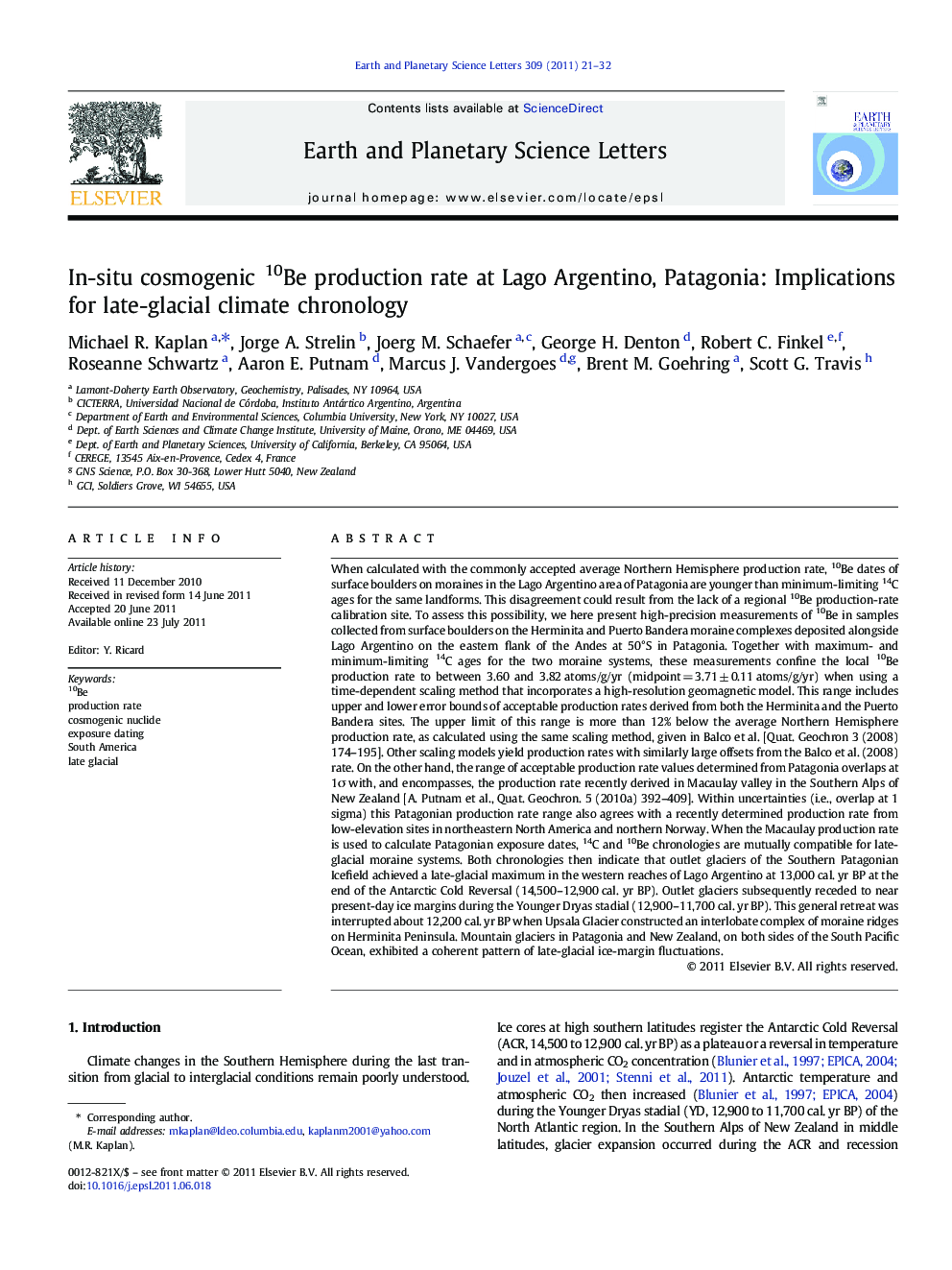| کد مقاله | کد نشریه | سال انتشار | مقاله انگلیسی | نسخه تمام متن |
|---|---|---|---|---|
| 4677930 | 1634822 | 2011 | 12 صفحه PDF | دانلود رایگان |

When calculated with the commonly accepted average Northern Hemisphere production rate, 10Be dates of surface boulders on moraines in the Lago Argentino area of Patagonia are younger than minimum-limiting 14C ages for the same landforms. This disagreement could result from the lack of a regional 10Be production-rate calibration site. To assess this possibility, we here present high-precision measurements of 10Be in samples collected from surface boulders on the Herminita and Puerto Bandera moraine complexes deposited alongside Lago Argentino on the eastern flank of the Andes at 50°S in Patagonia. Together with maximum- and minimum-limiting 14C ages for the two moraine systems, these measurements confine the local 10Be production rate to between 3.60 and 3.82 atoms/g/yr (midpoint = 3.71 ± 0.11 atoms/g/yr) when using a time-dependent scaling method that incorporates a high-resolution geomagnetic model. This range includes upper and lower error bounds of acceptable production rates derived from both the Herminita and the Puerto Bandera sites. The upper limit of this range is more than 12% below the average Northern Hemisphere production rate, as calculated using the same scaling method, given in Balco et al. [Quat. Geochron 3 (2008) 174–195]. Other scaling models yield production rates with similarly large offsets from the Balco et al. (2008) rate. On the other hand, the range of acceptable production rate values determined from Patagonia overlaps at 1σ with, and encompasses, the production rate recently derived in Macaulay valley in the Southern Alps of New Zealand [A. Putnam et al., Quat. Geochron. 5 (2010a) 392–409]. Within uncertainties (i.e., overlap at 1 sigma) this Patagonian production rate range also agrees with a recently determined production rate from low-elevation sites in northeastern North America and northern Norway. When the Macaulay production rate is used to calculate Patagonian exposure dates, 14C and 10Be chronologies are mutually compatible for late-glacial moraine systems. Both chronologies then indicate that outlet glaciers of the Southern Patagonian Icefield achieved a late-glacial maximum in the western reaches of Lago Argentino at 13,000 cal. yr BP at the end of the Antarctic Cold Reversal (14,500–12,900 cal. yr BP). Outlet glaciers subsequently receded to near present-day ice margins during the Younger Dryas stadial (12,900–11,700 cal. yr BP). This general retreat was interrupted about 12,200 cal. yr BP when Upsala Glacier constructed an interlobate complex of moraine ridges on Herminita Peninsula. Mountain glaciers in Patagonia and New Zealand, on both sides of the South Pacific Ocean, exhibited a coherent pattern of late-glacial ice-margin fluctuations.
► First production rate for 10Be exposure dating in Patagonia.
► This production rate is significantly lower than the average rate commonly used.
► Progress in geochronology allows new insights into late glacial paleoclimate.
► Glaciers advanced and receded during the ACR and YD, respectively, in the South.
Journal: Earth and Planetary Science Letters - Volume 309, Issues 1–2, 1 September 2011, Pages 21–32